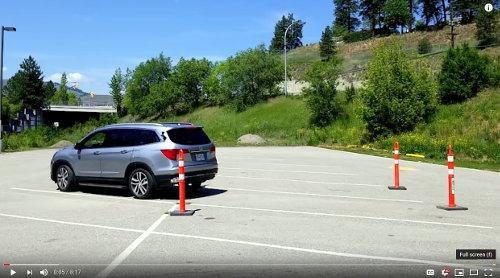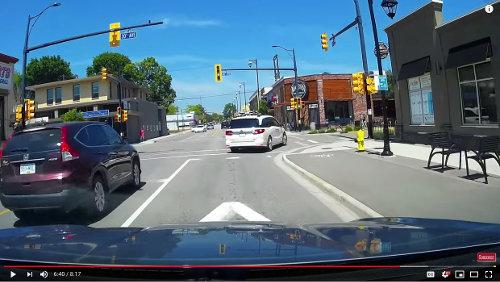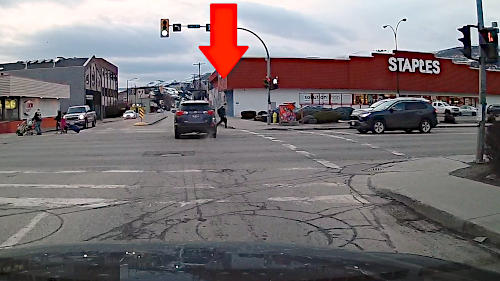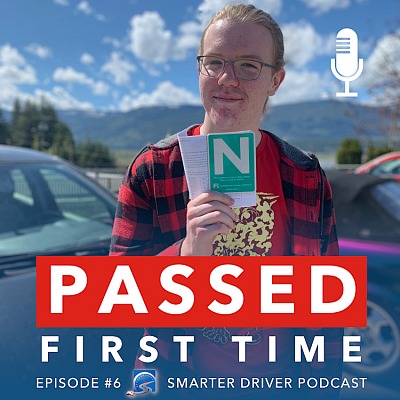4 Must Have Skills to Pass First Time!!
4 Must Have Skills to Pass Your Driver's Test
Closed Caption
Introduction
But for the purposes of passing your driver's test, you need to have four basic components in place.
SPACE MANAGEMENT
So the first thing, space management.
You need to have a three to four second following distance and you need to stop and traffic one vehicle length back from the vehicle in front of you.
Your landmark for that is you should be able to see the tires of the vehicle in front of you, making clear contact with the pavement.

You need to stop at the correct stopping position at controlled intersections before the stop line, before the crosswalk or sidewalk.
If those two conditions don't exist, then you need to stop at the edge of the road before entering the intersections.
And the reason we say space management is because if you're not near anything, it's less likely that you're going to hit anything, okay.
SPEED MANAGEMENT
Next one is speed management, posted speed limit or the flow of traffic, whichever is less, is the speed that you're going to drive.
And then observation.

You have your forward scanning pattern in place:
• down the road in,
• check your center mirror,
• far down the road,
• instrument panel,
• far down the road,
• left wing mirror, down the road,
• check your right wing mirror, okay.
So that's your forward scanning pattern and that ties into your speed control.
So if you're all over the map in terms of your speed and you can't keep it consistently at 30 miles an hour, if you're in a 30 mile an hour zone, that tells the examiner that you're not scanning properly.

OBSERVATION
So scanning pattern is tied into speed control.
As well, reversing 360° degree scan around the vehicle.
You're going to look out through the back window.
You can check your backup camera and you can check mirrors, but you can't use them as your primary line of sight.
So you need to look out through the back window when reversing.
Lane changes, mirror signal shoulder check, look forward again, minimum three flashes on your signal.
Okay, one click, two click, three click, look again, check your mirror, space is still there.

Then you start moving over, leave your signal on completely from one lane into the other lane, and then cancel your signal when you're completely in the other lane.
And you have to speed up slightly as you're changing lanes and moving into the other lane of traffic.
Those are your observation skills.
For more great information to become a safer, smarter driver, hit that thumbs up button and be sure to subscribe to the channel to become part of the smarter driver community.
Your driving test, there's a great deal of anxiety and uncertainty about what's going to happen on test day.
Pass your driver's test first time course package guarantees the information, skills and abilities you need to pass your driver's test first time.
As a bonus, we throw in both the winter and defensive driving smart courses to keep you safe and crash free after you get your license.
Click the link up in the corner here, head over to the smart drive test website.
And as well, signal shoulder check every time you change direction of the vehicle, both forward and in reverse, okay? Not just forward.
So if you're backing into a parking space, you need to signal that you're backing into the parking space as well for the purposes of your driver's test.

Drivers Have Different Ideas About Simple Techniques
The last one is communication.
And I was actually surprised about this.
I asked a question on the community tab a few weeks ago about when do you signal?
And I did not realize that so many people, so many different drivers had so many different ideas about when you signal, okay?
And people even had a go at me about saying that every time you change directions of the vehicle, you have to signal.
And they're like, "Well, if the road curves, then you have to signal according to your rules."

And I'm like, "Every time you change direction of the vehicle, not when the road changes directions of your vehicle, okay?"
So anytime that you're changing lanes, anytime you're turning, every time you're moving in a parking lot, you need to signal.
How Far From My Turn Should I Signal
And then of course, we got the 100 feet thing, we've got quarter mile thing, eighth of a mile thing, you know, all these different ideas about how far before the turn you actually signal.
It should be 10 to 12 flashes on the signal before you turn, okay?
So once you figure that out, how much distance 10 to 12 flashes is on your signal, that's how much you should be signaling before you get to the turn.
And of course, this is on my list of videos that I need to make because, oh, I love things that are controversial in driving.

So we're going to make a video on how to signal and when to signal, okay?
10 to 12 flashes of the signal, three minimum.
Before you change directions of the vehicle.
And yes, you need to signal in parking lots because signaling is communication and it's a backup, okay?
Observation & Communication Work Together
Because you did observe, you did look around.

Oh, there's nobody around, but you made a mistake because you were tired and you missed that person standing in your blind area and you didn't signal, which is your backup because it indicates that maybe the other person should do something because remember, driving is a social activity.
We need to work together to reduce traffic crashes, all right?
COMMUNICATION
The last piece of your driving test is communication.
As I said, position of the vehicle, position of the road user in relationship to the road or on the road, all right?
So if the vehicle is in the left turning lane, there's a high percentage, high possibility that that vehicle is going to turn left.

If the pedestrian is standing close to the crosswalk at the intersection, there's a high probability that that pedestrian is going to cross the roadway, okay?
Position of the vehicle, position of the road user, lights and signals, eye contact, especially if you're walking around, okay?
Because I do not trust vehicles when I'm walking around and I walk a lot, I get eye contact.
I'm figuring out what they're doing.
Hand gestures, come on, come on.
Don't tell them they're number one, especially on a driver's test.
And then the last one is horn.Use your horn sparingly, okay?
Because it's seen as a sign of aggression.
So four components to pass your driver's test to be successful.
Space management, speed management, observation and communication.
You have to have those four components in place to be successful on your driver's test.


